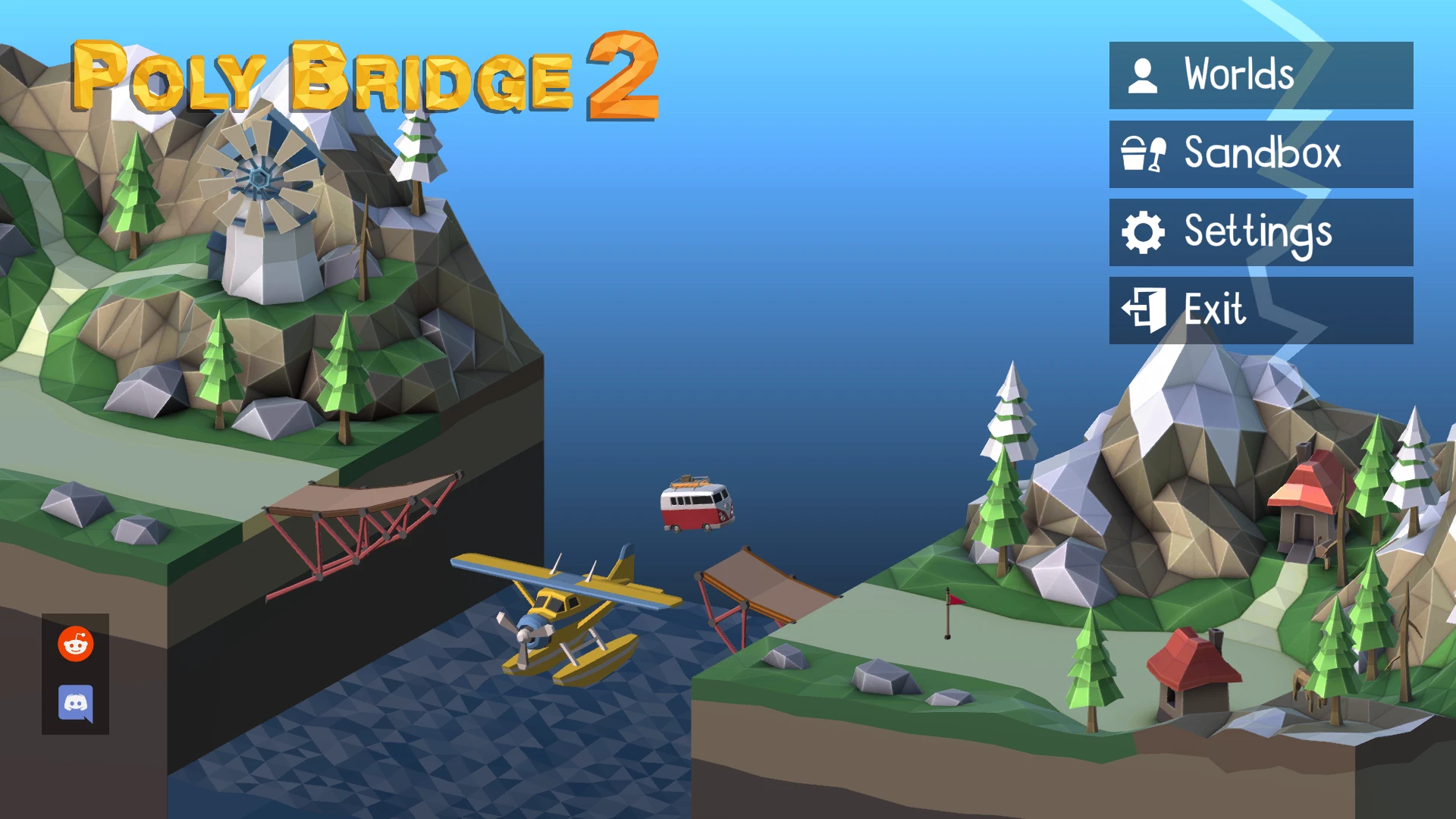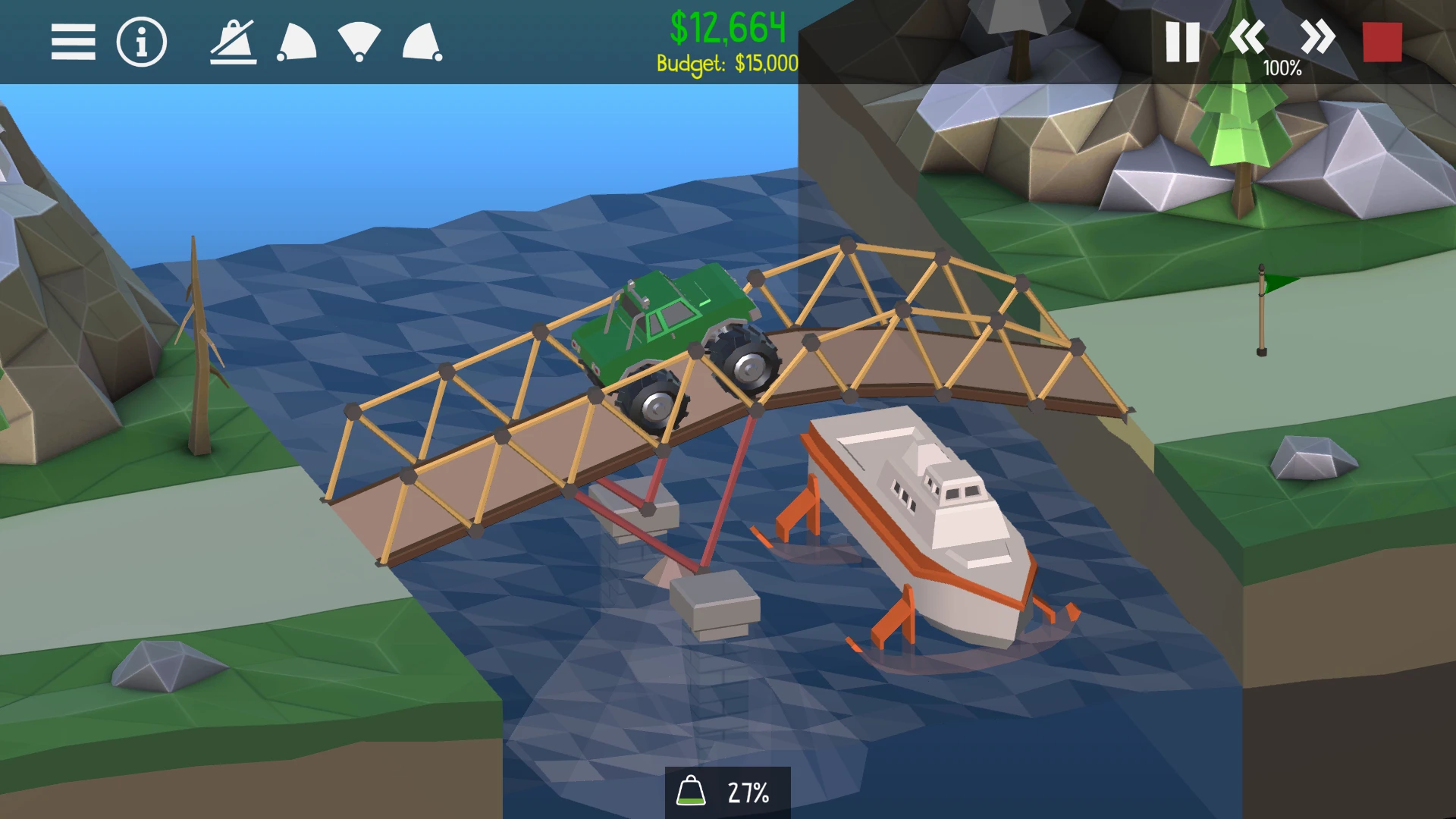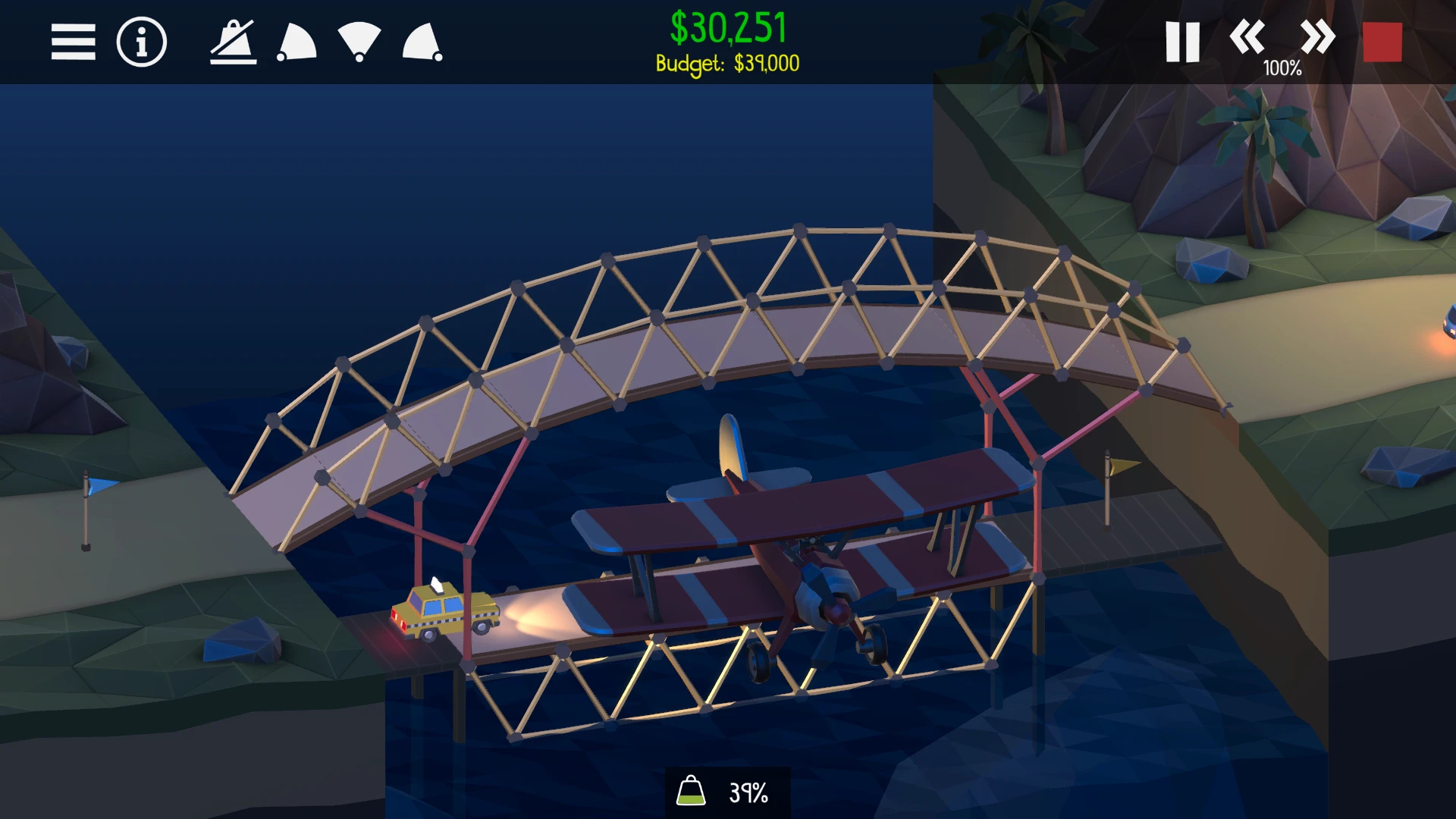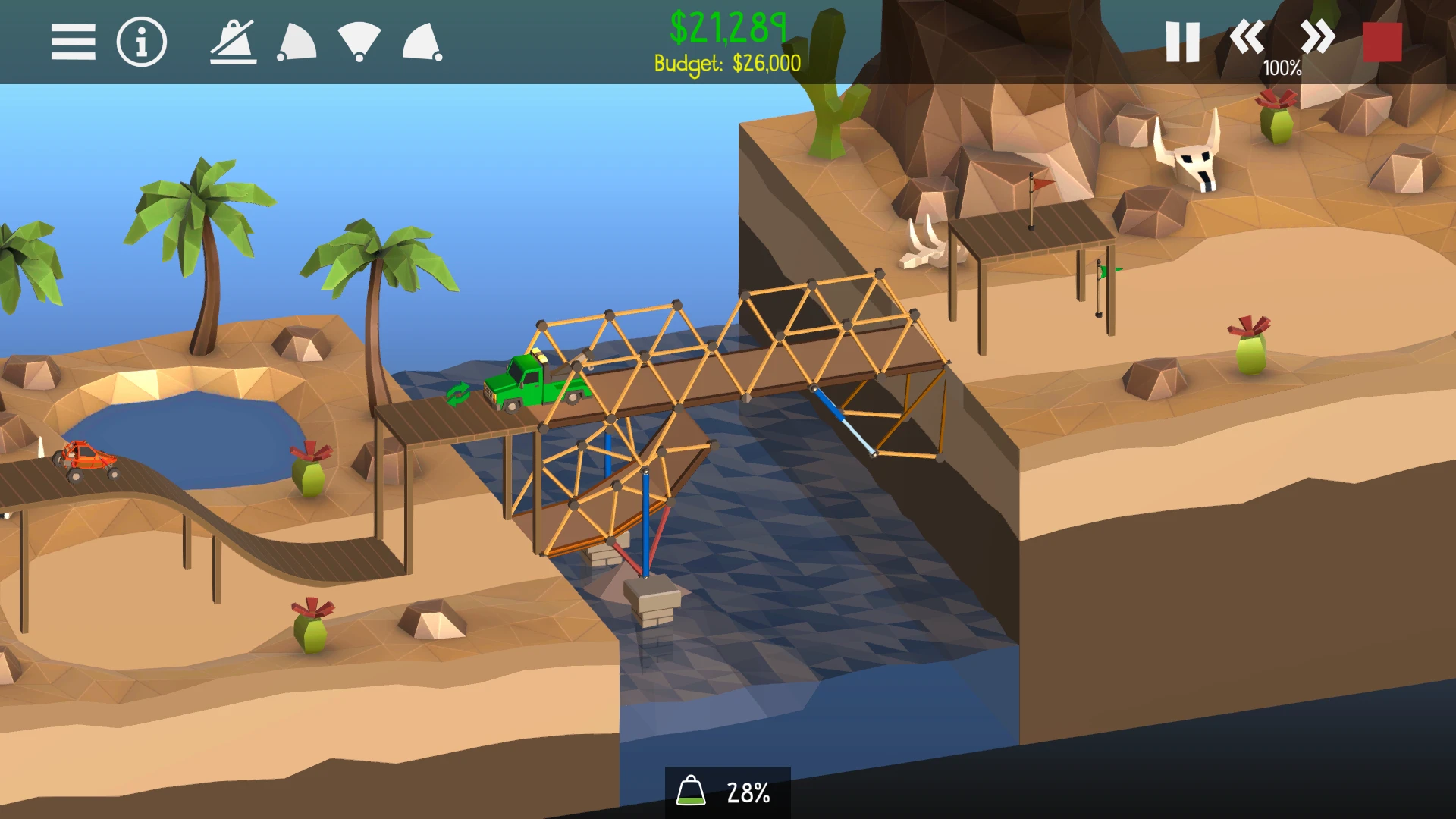 |
|
| Rating: 4.7 | Downloads: 500,000+ |
| Category: Simulation | Offer by: Dry Cactus Limited |
“Poly Bridge 2” is a physics-based construction bridge simulation game, belonging to the puzzle and strategy genre. Players design and build bridges to allow vehicles to cross from one side of a valley to another, with the core challenge being to create a structure that is both stable enough to withstand the weight and dynamic forces while using minimal resources, often measured in coins or materials. The game’s interest lies in its simple but deeply challenging core mechanics and the need for precise engineering thinking under constraints.
The gameplay of “Poly Bridge 2” offers a satisfyingly focused experience, appealing particularly to fans of logic puzzles and engineering simulators with its minimalist yet effective visual style. While lacking a traditional storyline, the incremental introduction of bridge physics, varied vehicle loads, and increasingly complex valley shapes provides inherent narrative progression and challenge. The core mechanic – drawing connections between anchor points – is intuitive yet requires careful planning and experimentation to master.
Gameplay and Features
- [Core Gameplay Loop]: Players connect anchor points across valleys by dragging lines (representing structural elements) to form a bridge. The objective is to create a bridge strong enough for a vehicle (truck, etc.) to traverse the gap successfully. Players interact with the game world by clicking/ tapping anchor points, dragging to draw connections, observing physics feedback on bridge stability, and managing a limited currency for resource efficiency.
- [Visuals or Art Style]: The game features a clean, monochrome (often black and white or muted color palettes) minimalist aesthetic. Structures and vehicles are represented by simple geometric shapes, and the environment is often stylized with flat landscapes and clear visual indicators for physics (like vehicle deformation or bridge collapse effects). The visuals are functional yet effective, emphasizing clarity and the core mechanics.
- [Modes or Levels]: Gameplay is primarily single-player focused on a linear, unlockable campaign consisting of numerous progressively challenging levels. Each level features a unique valley layout, vehicle type, load size, and often specific anchor point restrictions or currency limitations. This linear structure provides focused progression. The game offers replayability through multiple potential bridge designs for some levels, aiming for higher scores or efficiency, and potentially downloadable content (DLC) adding new vehicles, scenery packs, or entirely new bridge types in future updates.
- [Controls or Interface]: The interface is user-friendly, typically requiring only mouse/touch input. Players click/tap anchor points to select them, then drag to draw connecting lines. A visual preview of the structure is often provided, and controls are generally responsive. The simplicity of the controls combined with the depth of strategy makes the game accessible yet challenging.
- [Customization or Power-ups]: Customization primarily revolves around bridge design choices – selecting different materials, structural elements (like cables or struts), and deciding on the optimal layout. There is typically no traditional in-game shop or gear progression, but players can unlock cosmetic options like vehicle skins or scenery elements. The main “motivator” is overcoming the challenge of each level, achieving higher scores, and unlocking new content within the main campaign, often with community-shared designs or leaderboards for competition.
- [Any Special Systems]: While primarily focused on single-level completion, the community around “Poly Bridge 2” often shares custom levels (mods), adding user-generated content and significantly boosting replayability beyond the base game. Some levels may feature environmental hazards like wind or moving obstacles, or require balancing speed with structural integrity.
How to Play
Beginner’s Guide:
- Step 1: Download and install “Poly Bridge 2” from its official platform (e.g., Steam, mobile app store). Launch the game and familiarize yourself with the main menu. Start a new game or select the first level from the campaign.
- Step 2: On the level screen, identify the anchor points (usually marked with dots or small icons) on both sides of the valley. Click/tap the start anchor point, then drag your finger/mouse to the target point. Continue clicking/tapping and dragging across the valley, connecting points strategically to form a bridge.
- Step 3: Once the bridge is complete, a vehicle will drive onto it. Observe the bridge; if it breaks, the level fails. Use the limited currency earned or provided to modify your bridge or start over. If successful, the vehicle reaches the other side, and you advance to the next level, potentially earning score and currency.
Pro Tips:
- Plan strategically by sketching ideas on paper or using the in-game level editor if available.
- Start with basic straight designs and gradually add complexity. Balance material usage by adding supports where needed but minimizing elsewhere.
- Experiment with different connection patterns and materials early on; sometimes fewer, stronger lines (like using cables first) followed by trusses or planks yield better results than a dense structure.
Similar Games
| Game Title | Why It’s Similar |
|---|---|
| Bridge Constructor |
Shares a similar bridge construction puzzle genre. Known for its focus on physics accuracy and the challenge of building within resource limits across various scenarios. |
| Bridge Engineer |
Appeals to the same type of players seeking logical construction challenges. Offers a similar progression system and emphasizes engineering solutions with a minimalist style. |
| Bridge Constructor Elements |
Popular among fans for offering a refined version of the core bridge-building mechanic. It provides more detailed physics feedback and additional elements to incorporate into designs, enhancing replayability. |
Frequently Asked Questions
Q: How difficult is “Poly Bridge 2”, and are there different difficulty settings?
A: “Poly Bridge 2” is known for its steep learning curve combined with increasing challenge. While the core mechanics are simple, mastering efficient and strong bridge designs under tight budget constraints can be very difficult. The game typically lacks explicit difficulty settings, presenting levels sequentially with increasing complexity.
Q: Can I play “Poly Bridge 2” offline once downloaded, or is an internet connection required for gameplay?
A: “Poly Bridge 2” is primarily intended for single-player, offline enjoyment, much like its predecessors. A stable internet connection is only required initially for downloading and verifying the purchase, and possibly for online features like leaderboards or community level sharing.
Q: Is the gameplay in “Poly Bridge 2” suitable for all ages, or is it more geared towards a mature audience?
A: The gameplay of “Poly Bridge 2” is focused on spatial reasoning, physics, and engineering logic, making it appealing to a wide range of ages, from teens interested in STEM to adults simply enjoying a satisfying puzzle challenge. Its visual style is clean and minimalist, avoiding objectionable content.
Q: Are there plans for user-generated content, like creating and sharing my own custom bridges or levels for “Poly Bridge 2”?
A: While “Poly Bridge 2” might not have an integrated level editor or direct sharing feature at launch, the community often develops and shares custom levels (mods) independently, which players can sometimes import. Official support for UGC features like level creation tools is not confirmed but aligns with the trend in similar games.
Q: What happens when I complete all the main levels in “Poly Bridge 2”? Is there anything else to do?
A: Completing the main story/campaign in “Poly Bridge 2” usually unlocks a gallery displaying all successful bridges or achievement badges. The best way to unlock more content is through replaying levels for higher scores (e.g., aiming for the 1-star/bronze or 3-star/platinum ratings, depending on the game’s system), discovering more efficient designs. Community-shared user levels or any planned downloadable content (DLC), if released, would provide further content.
Screenshots
 |
 |
 |
 |
